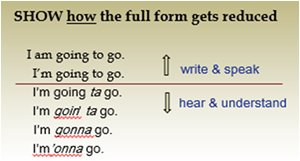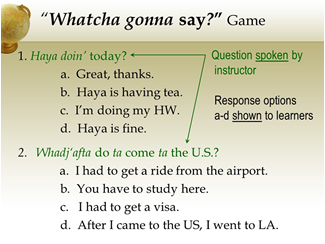ADVERTISEMENT
June 2016
Sh’wee teach’m Reductions?
Listening in a second language is challenging enough, but when native English speakers use reductions, even basic speech can become unrecognizable to ELLs. Native English speakers use reductions in their speech all the time, but learners often fail to capture the meaning or even recognize it as reduced speech.
Aural puzzlement happens to native speakers as well. For example, in a recent staff meeting a native-English-speaking colleague was certain she’d heard a new employee introduce herself as the “Student Vomit Coordinator.” Our colleague was so distracted, trying to figure out what the woman had really said, that she missed entirely the subsequent context of the introduction. Ah, yes. This was the new Student Involvement Coordinator. What important information had our friend missed while trying to figure out the new employee’s title? The point is, our ELLs may miss even more important spoken content when distracted by commonly used reductions (i.e., Whadja say?), and the speaker may be completely unaware that even simple sentences do not make sense to the ELL listener.
To make matters more confusing, reductions now appear frequently in informal writing, such as social media, for example. Yet learners with academic and professional aspirations must be able to distinguish between the written reductions they see and the formal writing they are expected to produce.
Therefore, weesh’d teach’m reductions because learners hear them and because comprehending commonly reduced forms can spare ELLs a good deal of linguistic frustration. This article focuses on what reductions are, what learners need, plus some activities for recognizing and responding to commonly used reductions, as well as identifying informal vs formal written forms.
What’r Reductions?
Like concentrated juices, reduced speech retains the most meaningful content, though some grammatical and phonological fluid has been removed. Teaching Pronunciation (Celce-Murcia, Brinton, & Goodwin, 1996) explains that “reduced speech… involve[s] unstressed vowels, omitted sounds, and other alternatives of the full form” (p. 230). Reduced forms often occur with other connected speech such as linking and assimilation (Brown & Kondo-Brown, 2006).
Reductions often involve:
Function words present for grammar and structure, such as:
- auxiliary verbs (Whadja do?)
- pronouns (help ‘im)
- conjunctions (this ‘n that)
- prepositions (good o’ you to come)
(Note: main verbs are not usually reduced, lest meaning be lost; exceptions include verbs like wanna and reducing progressive –ing ➞ -in’ as in doin’)Unstressed syllables
Vowel modification: can ➞ /kən/
Consonant sounds that are:
- missing: a lot of ➞ lotta, them/him ➞ ‘em
- radically changed: What are you ➞ Whatcha
Combinations of the above:
In extreme cases of reductions and linking, phrases may be heard as new words:
When did you get here? ➞ Whenja get ’ere?
Learners who hear “When did you get ear?” may think, “What a strange question. We are all born with ears.”
Whad’da Learners Need?
Learners Must Recognize Reductions
We consider reductions primarily a receptive skill and focus mainly on comprehension because:
Unless reductions and connected speech are taught specifically, learners are likely to miss, mishear, or misunderstand even familiar forms. For learners accustomed to carefully articulated ESL recordings of “shouldn’t have been,” hearing “should’n’a’bin” could easily be misinterpreted as a new word. To reduce such comprehension handicaps, ELLs need to recognize—and deserve to understand—just how “I am going to” could possibly become “I’m gonna” or even “I’m’onna” in spoken language.
Wherd’ya Draw the Line?
When learning to recognize reductions, ELLs benefit from intentional instruction followed by ongoing comprehension practice. One technique for introducing a reduced form is to show, step by step, how the full form gets condensed into reduced speech.
In “Wherd’ya draw the line?”, teachers choose a common reduction like “I’m gonna,” (click here for additional U.S. examples; PDF) and demonstrate its evolution from the most formal written form to the most reduced, informal, spoken form (See Figure 1; Moffie, 2012). Here’s how:

Figure 1. “Wherd’ya draw the line?” activity
Simple as this seems, we’ve seen students’ eyes open when using this technique, saying that while they had heard “I’m gonna go,” they never realized that it was the same as the “be going to” future tense they had learned in grammar class.
Additionally, activities like “Wherd’ya draw the line?” help learners distinguish between informal spoken English vs. standard written forms. Prior to texting and social media, it couldabin sufficient to teach learners only to recognize the spoken forms; however, ELLs now see reductions in informal writing on a daily basis. Learners also needta know what’s “acceptable,” particularly if they have academic and professional aspirations; assist them by clearly and consistently marking any unacceptable written forms.
Practice Responding to Reductions
Learners need a lot of practice recognizing and responding to reductions. In addition to using dictations, poems, and songs that include reductions, we recommend the following game, “Whatcha gonna say?” (See Figure 2; created collaboratively at INTO CSU). To play this game, the teacher asks the questions orally, and at first only the multiple-choice answers are visible to the learners. This forces learners to listen carefully and process the reduction along with the rest of the question. If the student has difficulty, the written question may later be revealed, showing the full form of the reduction that was spoken.

Figure 2. “Whatcha gonna say?” game
The first, simple question in Figure 2 is intended for a lower level learner. The second, more complex structure is a sample question better suited for an advanced learner. As you can see, learners must understand the meaning of the reduced form in order to choose an appropriate answer to each spoken question.
T’sum Up
When we teach ELLs to recognize, understand, and respond to reductions, their communication skills may be enhanced in several ways. Not only will they better comprehend reduced speech, but they also experience increased overall listening comprehension because they practice listening at a discourse level—beyond the mere form of the words they hear. This enables them to understand a wider variety of English speakers and typically results in greater conversational confidence, with smoother communication and more risk-taking. Finally, learners with the ability to draw the line between formal and informal written forms are better prepared for academic and professional English communication.
References
Brown, J. D., & Kondo-Brown, K. (Eds.). (2006). Perspectives on teaching connected speech to second language speakers. Honolulu, HI: National Foreign Language Resource Center.
Celce-Murcia, M., Brinton, D. M., & Goodwin, J. M. (1996). Teaching pronunciation. Cambridge, United Kingdom: Cambridge University Press.
Moffie, H. L. (2012, November). Teaching reductions: Whatcha gonna do with ‘em? Conference presentation at the annual conference for Colorado Teachers of English to Speakers of Other Languages, Denver, CO.
|
Download this article (PDF) |
Sarita Z. Crawford earned her BA in English at the University of Colorado at Colorado Springs and her MA in communications development with an emphasis on teaching composition and ESL from Colorado State University. She has taught in adult basic education, postsecondary, and intensive English programs. Sarita currently resides in Colorado, where she teaches academic English and Pathway ESL courses and coordinates the Academic Success Center at INTO CSU.
Heather L. Moffie enjoys helping learners make connections: with others, within language, and to life-changing ideas. Her interests include personal mentoring, music, nature, and seeing an end to human trafficking. Heather has taught adult ESL in Virginia, Ukraine, and Kazakhstan, and she currently teaches academic English and Pathway ESL courses at INTO Colorado State University.
Director, English Language Program; Yachay Tech; Urcuquí, Imbabura Province, Ecuador
ESL Program Director; Troy University; Troy, Alabama, USA
To browse all of TESOL's job postings, check out the TESOL Career Center.